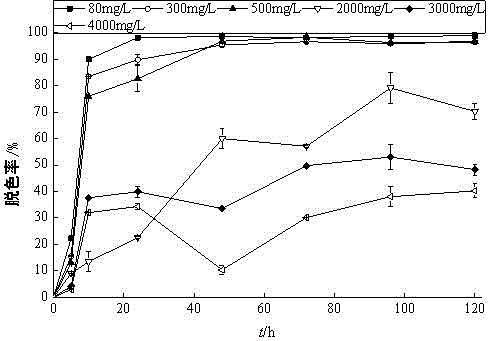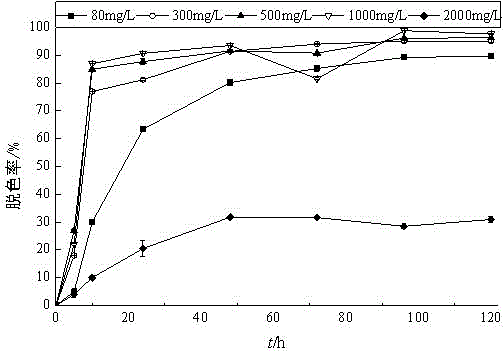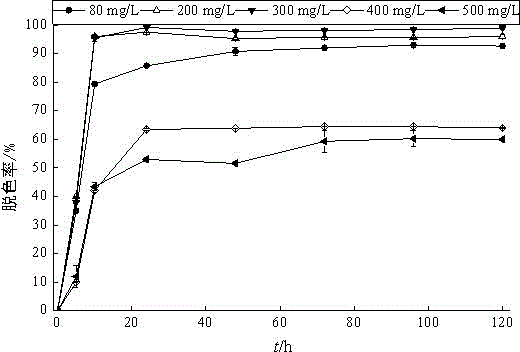Bacterial strain for degrading dye with high efficiency
A high-efficiency, strain-based technology, applied in bacteria, microbial-based methods, water/sludge/sewage treatment, etc., to achieve good ecological efficiency and application prospects, avoid environmental pollution, and broad-spectrum dye degradation capabilities
- Summary
- Abstract
- Description
- Claims
- Application Information
AI Technical Summary
Problems solved by technology
Method used
Image
Examples
Embodiment 1
[0044] Example 1 Lysinibacillus sp . FS1 Isolation of strains
[0045] 1. Strain activation and enrichment
[0046] Take 50mL of activated sludge sample (taken from the wastewater treatment aeration tank of Guangzhou Industrial Park, Guangdong Province), put it into an Erlenmeyer flask containing 50mL of sterile water (with several glass beads inside), and shake it on a shaker for 30 minutes. Loose mud. Take 5mL of the dispersed mud sample, inoculate it into 100mL of enriched medium, add 30mg / L of Acid Red B dye, and culture with shaking at 37°C and 200rpm for 16-24 hours.
[0047] The composition of the enrichment medium is: beef extract 1g, peptone 2g, glucose 3g, K 2 HPO 4 2g, NaH 2 PO 4 0.5g, MgSO 4 ·7H 2 O 0.2g, MnSO 4 ·7H 2 O 0.02g, FeCl 3 ·7H 2 O 0.01g, CaCl 2 0.02g, 1L sterile water, pH 7.2; sterilize the culture medium at 121°C for 15-30 minutes.
[0048] 2. Strain screening and purification
[0049] Dilute the enriched culture solution with obvious decolorization effec...
Embodiment 2
[0051] Example 2 Lysinibacillus sp. Test on the decolorization effect of FS1 on different concentrations of methylene blue
[0052] The strain FS1 that efficiently degrades the dye of the present invention is inoculated into a liquid medium, and cultured on a shaker at 30-37°C and 150 rpm for 10-24 hours to obtain the culture broth of the strain; the composition of the liquid medium is: 2g glucose, 1g ammonium chloride, NaH 2 PO 4 0.5g, K 2 HPO 4 2g, FeSO 4 ·7H 2 O 0.01g, MgSO 4 ·7H 2 O 0.2g, CaCl 2 0.02g, 1L water, pH7.2.
[0053] Take the logarithmic growth period (OD 600 =1) Lysinibacillus sp. FS1 culture medium, 1% (V / V) into 100mL of decolorizing basic medium, adding different concentration gradients (80mg / L, 500mg / L, 2000mg / L, 3000mg / L, 4000mg / L, 5000mg / L) Methylene blue dye. The three were cultured in parallel at room temperature, and the absorbance of the culture medium was measured every 5-24 h.
[0054] The decolorization rate was used to investigate the decoloriza...
Embodiment 3
[0058] Example 3 Lysinibacillus sp. The decolorization effect test of FS1 on different concentrations of neutral red
[0059] Referring to Example 2, the strain was cultured, and the logarithmic growth phase (OD 600 =1) strain FS1 culture solution, 1% (V / V) into 100mL decolorizing basic medium, adding different concentration gradients (80mg / L, 300mg / L, 500mg / L, 1000mg / L, 2000mg / L) neutral red dye. Others are the same as in Example 2.
[0060] The test results are attached Figure 4 As shown, when the concentration of neutral red is 300~1000mg / L, the decolorization rate basically reaches about 90% of the maximum decolorization rate within 10h. When the concentration increases, the strain decolorization time increases by about 48h. As the concentration of neutral red increases, the ability of the strain to decolorize it gradually decreases, from 99% to 30%. Strain Lysinibacillus sp. FS1 The highest decolorization concentration of neutral red is as high as 2000mg / L.
PUM
| Property | Measurement | Unit |
|---|---|---|
| diameter | aaaaa | aaaaa |
| diameter | aaaaa | aaaaa |
| decolorization rate | aaaaa | aaaaa |
Abstract
Description
Claims
Application Information
 Login to View More
Login to View More - R&D
- Intellectual Property
- Life Sciences
- Materials
- Tech Scout
- Unparalleled Data Quality
- Higher Quality Content
- 60% Fewer Hallucinations
Browse by: Latest US Patents, China's latest patents, Technical Efficacy Thesaurus, Application Domain, Technology Topic, Popular Technical Reports.
© 2025 PatSnap. All rights reserved.Legal|Privacy policy|Modern Slavery Act Transparency Statement|Sitemap|About US| Contact US: help@patsnap.com



